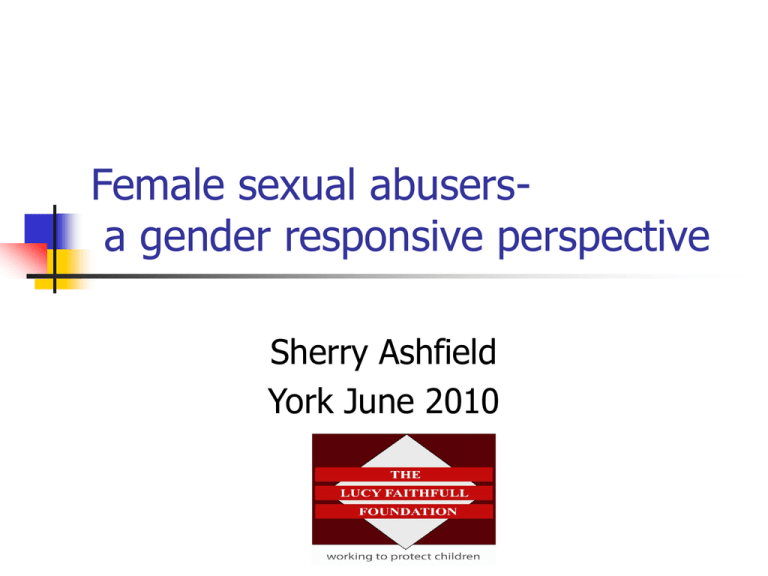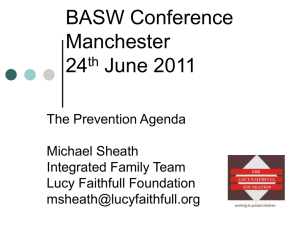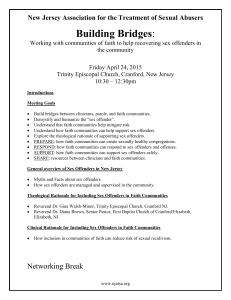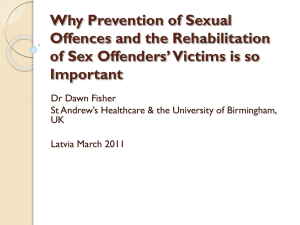
Female sexual abusersa gender responsive perspective
Sherry Ashfield
York June 2010
Aim
Increase knowledge of basic
research relating to female sex
offenders
Explore the importance of gender
Consider practical implications
Who we are
The Lucy Faithfull Foundation is a child
protection charity specialising in
sexually harmful behaviours.
Work is completed in family court and
criminal justice settings.
The adolescent team is funded by the
Youth Justice Board and has teams
based in 6 prison establishments
Funding has also been made available
for individual assessments of adolescent
females within the secure estate.
Work completed with female sexual
abusers in a criminal justice setting.
The Female Outreach Project was set up in 2001 following the
completion of a pilot SOTP in HMP Styal to offer an assessment
and consultancy service to women who were not able to access
any other treatment. In March 2009-10 involvement occurred in
<40 cases.
Training and liaison has also been completed with four
‘approved premises’ for women.
From April 2010 funding has been devolved to individual DOMS
–this has significant implications for treatment provisions
LFF maintains close links with HM Prison Service and a range of
research projects through Birmingham and Swansea University.
Although the Ministry Of Justice has indicated its plans to roll
out a strategy for female sexual offenders this remains in the
early research stages.
Perceptions of female abuse
Western society finds it very difficult to
equate a nurturing, passive view of
femininity with violence and sexual
aggression, particularly toward children
(Bunting, 2007; Denov, 2003, 2004;
Hetherton, 1999; Saradjian, 1996).
Female sexual abuse;
reaction of professionals
Professional groups viewed female sexual
abuse as less harmful than sexual abuse by
men. Moreover they made efforts either
consciously or unconsciously to transform the
female and her behaviour into more culturally
acceptable notions of female behaviour. This
ultimately led to denial of the problem.
(Study with Police and other professionals
Denov 2001,2003)
Professional Responses
in Britain (NSPCC 2005)
Lack of professional awareness
Policies and procedures not used when
abuser is female
Women rarely seen as equal partners
Less inclination to prosecute; greater
evidence needed
Training a key issue in awareness raising
Policies and procedures should explicitly
recognise female sex offenders
Bunting (2005) NSPCC
Common ‘explanations’
She’s just over affectionate
He must have forced her into it
He was very grown up
Her motive can’t be sexual, so she’s not
really doing much harm
She really did mean to do it – women
don’t do that - she’s evil (or she’s
insane)!
Gender Bias/Gender Blind (Miller
2003)
Gender biased –
rooted in
stereotypical beliefs
about females and
tend to view female
abusers as very
different to males in
terms of offences
and motivations
Focus on
victimisation
Gender blind-Begin
from an assumption
that female abusers
are no different to
males and disregard
concept of gender
View victimisation as
attempts to make
excuses for
behaviours
Gender Responsiveness
Policy makers must acknowledge gender
makes a difference.
(US Department of Justice 2007)
What is gender ?
Gender is about the reality of women’s
lives and the context in which women
live.
(Covington 2001) .
Gender responsiveness
What does it mean
Gender Responsiveness
Creating an environment through site
selection, staff selection, programme
development ,content and material that
reflects an understanding of the
realities of the lives of women and girls
and that responds to their strengths
and challenges.
(Covington and Bloom 2006)
What are the realities of female sex
offenders lives?
Multiple abuse in childhood often by caretaking figure
Abuse experiences more extensive and severe than other female
offenders
Previous exploitative and/or abusive relationships in adulthood- may be
ongoing
History of depression prior to offending
Undiagnosed PSTD and other trauma symptoms but evidence re
definable mental impairment not consistent.
Poor emotional regulation
Social isolation,
Low self worth
Limited experience of employment /training
Often primary caregivers for children, may be lone parents
(Gannon &Rose,2008,Fromuth &Conn 1997,Elliott,Eldridge,Ashfield
2007,Grayston &De Luca1999)
Realities of parenting styles
44% reported inability to cope with
their children
60% were reported to have an
inattentive or neglectful parenting style
37% had received local authority
assistance
(Eldridge,Elliott Ashfield, Beech 2007)
Realities: abuse of children and
other adults
Sometimes over hours, sometimes days
sometimes years
Range of motivations: sexual
arousal,anger,desire for power, desire to
maintain relationships,money,revenge
Range of victims: male ,female, babies
adolescents, adults
Sometimes alone, sometimes with others
Realities following detection
Shame- sense of doubly deviant
Fear –personal and emotional safety
Suspicion- legacy of previous
experiences
Loss- home /children ,including removal
at birth
Rejection- by professionals
Similarities with male sex
offenders
Similarities in age,ethnicity,educational
levels, job stresses and other life
stresses. (Micco-Fonseca 2000)
Similar offence supportive cognitions
regarding the nature of harm- ie abuse
is not harmful (Beech et al 2008)
Differences compared with
males
More likely to have experienced verbal, physical and
sexual abuse from childhood (Gannon &Rose 2008)
Sexual abuse more severe and frequent than male
counterparts
More likely to have previous suicide attempts (Micco
–Fonseca 2000)
More likely to co-offend with another, usually male
More likely to abuse in care giving situation
(Giguere & Bumby,Center for Sex Offender
Management, USA 2007)
More likely to be trapped in abusive relationships
through adulthood. (Lewis &Stanley 2000)
Difference compared with
males :contd
More likely to have traits of severe passivity and
dependency (Lewis and Stanley 2000,Gannon,Rose
&Ward2009 in press)
Higher levels of low self esteem ,emotional loneliness
and externalised locus of control (Beckett 2007)
Less likely to report use of alcohol or drugs around
time of offence
Lower levels of emotional congruence with children
(Beckett 2007)
Less global cognitions re children and sex(Gannon
2009)
Lower rates of reconviction:1.8-6%(Cortoni 2008,
Sandler &Freedman 2009)
Work in Custody and the
Community
Lack of experience, knowledge and
confidence in working with female sex
offenders expressed by staff
Difficulty in preparing pre sentence reports,
parole/lifer reports
Assistance needed in dealing with prison
behaviour, e.g. sexually inappropriate
behaviour, networking
Requests for assistance in managing women
unsuitable for intervention.
Challenges That Face Women
In Examining Their Behaviour
Attitude Of Professionals
Attitude Of Parents/Family
Personal Sense Of Shame
Be aware of what the woman
may bring to the interview
Fear
Suspicion
Shame
Anger
Emotional Distress
Personal Abuse History
High levels of sexual arousal
Be Aware Of What You May
Bring To The Interview
Your prejudices and stereotypes
(Monster/victim/highly devious/misunderstood)
Your personal/professional anxieties
(don’t feel confident/where’s the handbook?)
Lack of awareness of ongoing issues
(Failure to liaise with other disciplines)
Overconfidence
(Just the same as other women- downplaying
abusive behaviours of offence and risk of
harm)
In order to engage effectively and
therapeutically with this group,
professionals need to reassess their
personal belief systems and the degree to
which these inform professional practice .
Ashfield et al 2010(in press)
Significance of therapeutic
processing
‘Error’ in male sex offender discipline
has been lack of attention to
therapeutic process variables (Marshall
et al 2003
Attention to such process variables hold
significance for successful treatment
outcomes (Levenson and Prescott 2009)
It is not what the practitioner
does
but the client’s perception of the
practitioner’s behaviour that
determines treatment outcomes
Horvath 2000
Feedback from female sex
offenders
Professionals share their
lack of experience and
knowledge with them
Professionals show
surprize at their
behaviour or always
relate back to male so’s
Professionals talk ‘at
them’ not to them
Professionals label
everything they say as
deviant or manipulative
Women feel increased
sense of vulnerability
and fear
Women feel ‘doubly
deviant’ as a female
who is also a sex
offender
Professionals don’t
listen
Professionals fail to
recognise their need
for survival mechanisms
Words/Phrases to use with Caution
MANIPULATIVE
IN DENIAL
NOT MOTIVATED
Is she or is it a survival
strategy? Consider what
‘function’ her behaviour
might serve.
What strategies will she
need to survive if she
accepts who she really
is,ie a sex offender?
Are you? Does she need
to start with the bits
she can talk about,
What's in it for her?
How good is your
selling technique?
Top 10 Tips for positive
engagement
Confidence in the worker’s
ability-saying you are my
first/only doesn’t help!!!
Shared realistic goals –”an
abuse free life for you and
others” Important not to
collude but to name abuse
for what it is.
Appropriate boundaries-a
‘girls together’ approach
doesn’t work neither does
lack of liasion with other
professionals
Shared language- “what
does OK mean? Sexy
thinking—” Motivational
statements re hope of
change-this can be a new
beginning, we believe that
with support you can make
good choices--
Motivational Statements
We believe that with support you can make
sense of how you came to be here( a
convicted abuser)
We believe change is possible but recognise
that at this point you may need us to believe
it for you.
We know change is difficult and will take time
and effort for all of us.
We believe that you can make good choices
and maintain a positive,offence free life.
Positive engagement -contd
Recognition of progress- change takes time
Personal disclosure –(within sensible limits) if you are
too detached you will be seen as rejecting.
Recognition of survival strategies for what they aredissociation,avoidance,selective information
sharing,denial.Some things are just too difficult at
this stage-she needs to survive on a daily basis.
Collaboration rather than confrontation-remember
the powerlessness associated with previous abuse.
Flexibility –responsive to needs, indicates you ‘hear’
her concerns etc.
Reading List
Bunting, L. (2005). Females who sexually offend against
children: Responses of the child protection and criminal justice
systems. NSPCC Policy Practice Research Series. London:
NSPCC.
Covington, S. S. (2002, January). A woman’s journey home:
Challenges for female offenders and their children. Working
paper presented at the National Policy Conference of the U.S.
Department of Health and Human Services:
Denov, M. S. (2001). A culture of denial: Exploring professional
perspectives on female sex offending. Canadian Journal of
Criminology, 43, 303-329.
Eldridge, H., Elliott, I. A., & Ashfield, S. (2009). Assessment of
women who sexually abuse children. In M.C. Calder (Ed.),
Sexual abuse assessments: Using and developing frameworks
for practice (pp. 213-227). London: Russell House Publishing.
Reading list
• Eldridge, H. J., & Saradjian, J. (2000). Thousand Oaks, CA:
Sage.Replacing the function of abusive behaviours for the
offender: Remaking relapse prevention in working with women
who sexually abuse children. In D. R. Laws, S. M. Hudson, & T.
Ward, (Eds), Remaking relapse prevention with sex offenders: A
sourcebook (pp. 402-426).
Ford, H. (2006). Women who sexually abuse children.
Chichester, UK: John Wiley & Sons.
Gannon&Rose,Journal Of Aggression and Violent Behaviour 13
(2008)442-461
Giguere, R., & Bumby, K. (2007). Female sex offenders [Policy
and Practice Brief]. Center for Sex Offender Management, USA.
Peter, T. (2008). Speaking about the unspeakable: Exploring the
impact of mother-daughter sexual abuse. Violence against
Women, 14, 1033-1053.
Assessment, Intervention,
Training, Consultancy
Assessment materials
Intervention materials
Training
Case consultancy
Referral: To: Lucy Faithfull Foundation
Tel: 0044 (0)1527 591922












